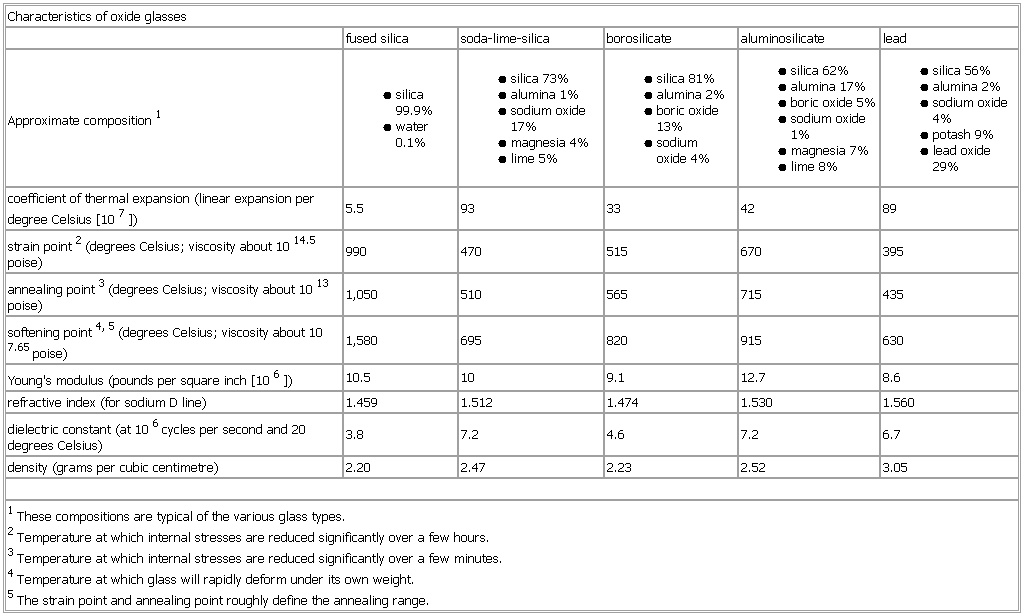Characteristics of oxide glasses
- Characteristics of oxide glasses
-
Characteristics of oxide glasses
fused silica soda-lime-silica borosilicate aluminosilicate lead
Approximate composition1
● silica 99.9%
● water 0.1%
● silica 73%
● alumina 1%
● sodium oxide 17%
● magnesia 4%
● lime 5%
● silica 81%
● alumina 2%
● boric oxide 13%
● sodium
oxide 4%
● silica 62%
● alumina 17%
● boric oxide 5%
● sodium oxide 1%
● magnesia 7%
● lime 8%
● silica 56%
● alumina 2%
● sodium oxide 4%
● potash 9%
● lead oxide 29%
coefficient of thermal expansion (linear expansion per degree Celsius [107]) 5.5 93 33 42 89
strain point2 (degrees Celsius; viscosity about 1014.5 poise) 990 470 515 670 395
annealing point3 (degrees Celsius; viscosity about 1013 poise) 1,050 510 565 715 435
softening point4, 5 (degrees Celsius; viscosity about 107.65 poise) 1,580 695 820 915 630
Young's modulus (pounds per square inch [106]) 10.5 10 9.1 12.7 8.6
refractive index (for sodium D line) 1.459 1.512 1.474 1.530 1.560
dielectric constant (at 106 cycles per second and 20 degrees Celsius) 3.8 7.2 4.6 7.2 6.7
density (grams per cubic centimetre) 2.20 2.47 2.23 2.52 3.05
1These compositions are typical of the various glass types.
2Temperature at which internal stresses are reduced significantly over a few hours.
3Temperature at which internal stresses are reduced significantly over a few minutes.
4Temperature at which glass will rapidly deform under its own weight.
5The strain point and annealing point roughly define the annealing range.
See as table:
* * *
Universalium.
2010.
Look at other dictionaries:
amorphous solid — ▪ physics Introduction any noncrystalline solid in which the atoms and molecules are not organized in a definite lattice pattern. Such solids include glass, plastic, and gel. Solids and liquids (liquid) are both forms of condensed… … Universalium
industrial glass — Introduction solid material that is normally lustrous and transparent in appearance and that shows great durability under exposure to the natural elements. These three properties lustre, transparency, and durability make glass a favoured… … Universalium
Glass — This article is about the material. For other uses, see Glass (disambiguation). Moldavite, a natural glass formed by meteorite impact, from Besednice, Bohemia … Wikipedia
glass — glassless, adj. glasslike, adj. /glas, glahs/, n. 1. a hard, brittle, noncrystalline, more or less transparent substance produced by fusion, usually consisting of mutually dissolved silica and silicates that also contain soda and lime, as in the… … Universalium
Glass — /glas, glahs/, n. 1. Carter, 1858 1946, U.S. statesman. 2. Philip, born 1937, U.S. composer. * * * I Solid material, typically a mix of inorganic compounds, usually transparent or translucent, hard, brittle, and impervious to the natural elements … Universalium
Optical fiber — A bundle of optical fibers A TOSLINK fiber optic audio c … Wikipedia
Materials science — Simulation of the outside of the Space Shuttle as it heats up to over 1,500 °C (2,730 °F) during re entry into the Earth s atmosphere Materials science is an interdisciplinary field applying the properties of matter to various areas of… … Wikipedia
Neodymium — praseodymium ← neodymium → promethium ↑ Nd ↓ U … Wikipedia
Borosilicate glass — is a type of glass with the main glass forming constituents silica and boron oxide. Borosilicate glasses are most well known for having very low coefficient of thermal expansion ( 5 / 0 6 / C at 20oC), making them resistant to thermal shock, more … Wikipedia
Diamond simulant — Due to its low cost and close visual likeness to diamond, cubic zirconia has remained the most gemologically and economically important diamond simulant since 1976. The high price of gem grade diamonds, as well as significant ethical concerns of… … Wikipedia

